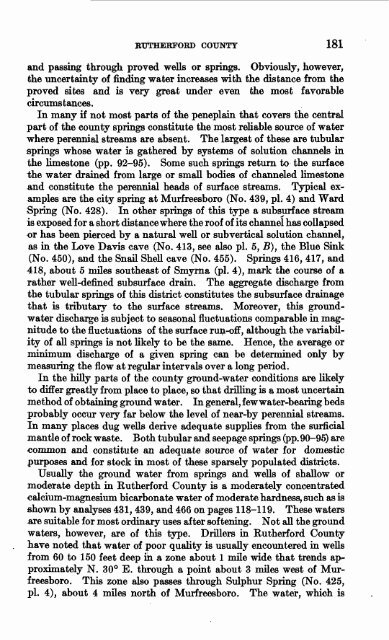GROUND WATER IN NORTH-CENTRAL TENNESSEE
GROUND WATER IN NORTH-CENTRAL TENNESSEE
GROUND WATER IN NORTH-CENTRAL TENNESSEE
Create successful ePaper yourself
Turn your PDF publications into a flip-book with our unique Google optimized e-Paper software.
RUTHERFORD COUNTY 181<br />
and passing through proved wells or springs. Obviously, however,<br />
the uncertainty of finding water increases with the distance from the<br />
proved sites and is very great under even the most favorable<br />
circumstances.<br />
In many if not most parts of the peneplain that covers the central<br />
part of the county springs constitute the most reliable source of water<br />
where perennial streams are absent. The largest of these are tubular<br />
springs whose water is gathered by systems of solution channels in<br />
the limestone (pp. 92-95). Some such springs return to the surface<br />
the water drained from large or small bodies of channeled limestone<br />
and constitute the perennial heads of surface streams. Typical ex<br />
amples are the city spring at Murfreesboro (No. 439, pi. 4) and Ward<br />
Spring (No. 428). In other springs of this type a subsurface stream<br />
is exposed for a short distance where the roof of its channel has collapsed<br />
or has been pierced by a natural well or subvertical solution channel,<br />
as in the Love Davis cave (No. 413, see also pi. 5, B), the Blue Sink<br />
(No. 450), and the Snail Shell cave (No. 455). Springs 416, 417, and<br />
418, about 5 miles southeast of Smyrna (pi. 4), mark the course of a<br />
rather well-defined subsurface drain. The aggregate discharge from<br />
the tubular springs of this district constitutes the subsurface drainage<br />
that is tributary to the surface streams. Moreover, this ground-<br />
water discharge is subject to seasonal fluctuations comparable in mag<br />
nitude to the fluctuations of the surface run-off, although the variabil<br />
ity of all springs is not likely to be the same. Hence, the average or<br />
minimum discharge of a given spring can be determined only by<br />
measuring the flow at regular intervals over a long period.<br />
In the hilly parts of the county ground-water conditions are likely<br />
to differ greatly from place to place, so that drilling is a most uncertain<br />
method of obtaining ground water. In general, few water-bearing beds<br />
probably occur very far below the level of near-by perennial streams.<br />
In many places dug wells derive adequate supplies from the surficial<br />
mantle of rock waste. Both tubular and seepage springs (pp. 90-95) are<br />
common and constitute an adequate source of water for domestic<br />
purposes and for stock in most of these sparsely populated districts.<br />
Usually the ground water from springs and wells of shallow or<br />
moderate depth in Rutherford County is a moderately concentrated<br />
calcium-magnesium bicarbonate water of moderate hardness, such as is<br />
shown by analyses 431, 439, and 466 on pages 118-119. These waters<br />
are suitable for most ordinary uses after softening. Not all the ground<br />
waters, however, are of this type. Drillers in Rutherford County<br />
have noted that water of poor quality is usually encountered in wells<br />
from 60 to 150 feet deep in a zone about 1 mile wide that trends ap~<br />
proximately N. 30° E. through a point about 3 miles west of Mur<br />
freesboro. This zone also passes through Sulphur Spring (No. 425,<br />
pi. 4), about 4 miles north of Murfreesboro. The water, which is

















